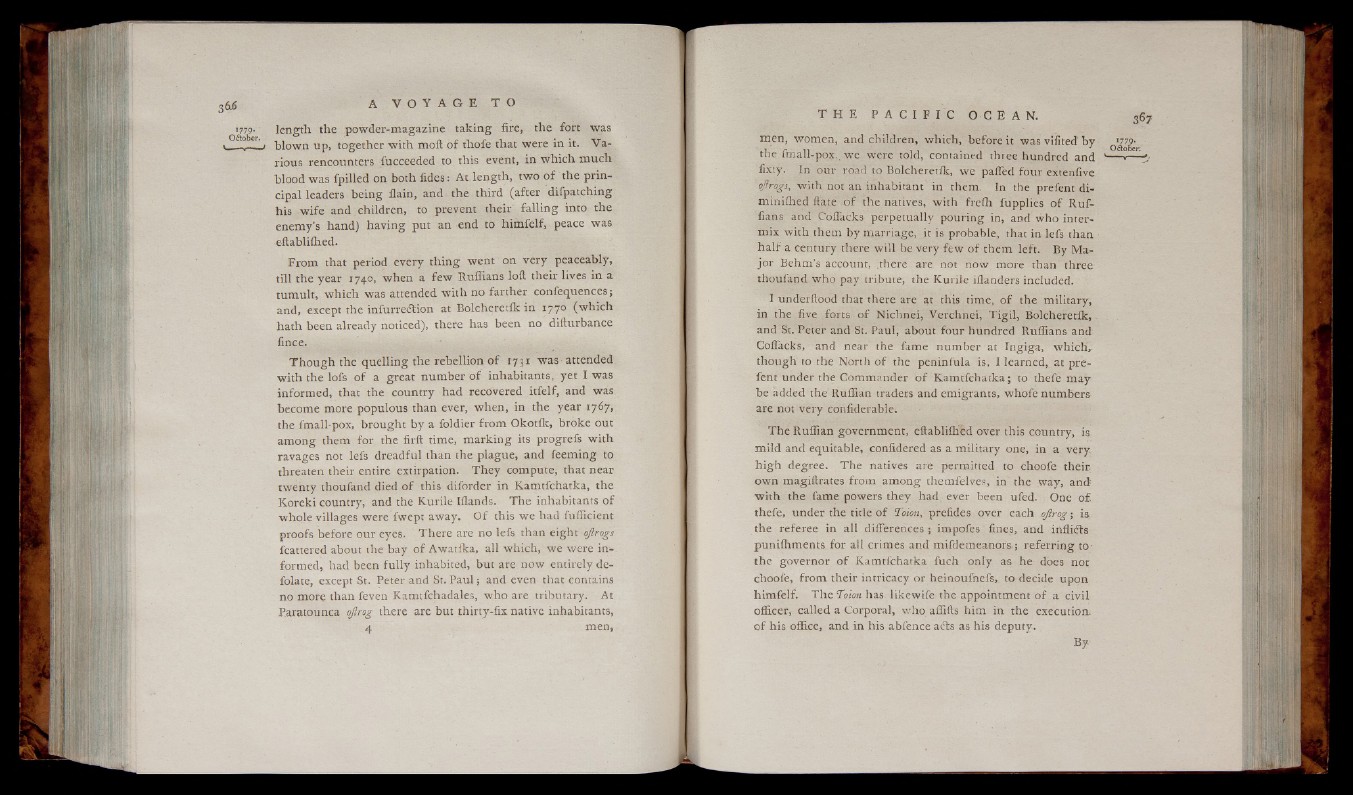
1779. length the powder-magazine taking fire, the fort was
. _°_er 1 blown up, together with moil o f thofe that were in it. V a rious
rencounters fucceeded to this event, in w hich much
blood was fpilled on both fides: At length, two o f the principal
leaders being flain, and the third (after difpatching
his w ife and children, to prevent their fa llin g into the
enemy’s hand) having put an end to himfelf, peace was
eftabliffied.
From that period every thing went on ve ry peaceably,
till the year 1740, when a few Ruffians loft their lives in a
tumult, which was attended w ith no farther confequences;
and, except the infurredlion at Bolcheretik in 1770 (which
hath been already noticed), there has been no difturbance
fince.
T h o u gh the quelling the rebellion o f 1731 was attended
with the lofs o f a great number o f inhabitants, yet I was
informed, that the country had recovered itfelf, and was
become more populous than ever, when, in the year 1767,
the fmall-pox, brought by a foldier from Okotfk, broke out
among them for the firft time, marking its progrefs with
ravages not lefs dreadful than the plague, and feeming to
threaten their entire extirpation. The y compute, that near
twenty thoufand died o f this diforder in Kamtfchatka, the
Koreki country, and the Kurile Iflands. The inhabitants o f
whole villages were fwept away. O f this w e had fufficient
proofs before our eyes. The re are no lefs than eight ojlrogs
fcattered about the bay o f Awatfka, all which, we were informed,
had been fu lly inhabited, but are now entirely defolate,
except St. Peter and St. P a u l; and even that contains
no more than feven Kamtfchadales, who are tributary. At
Paratounca ojirog there are but thirty-fix native inhabitants,
4 men,
men, women, and children, which, before it was vifited by J77?.
the fmall-pox. we were told, contained three hundred and .' <—
fixty. In our road to Bolcheretik, we palled four extenfive
ojirogs, with not an inhabitant in them. In the prefent di-
miniffied ftate o f the natives, with freih fupplies o f Ruffians
and Coffacks perpetually pouring in, and who intermix
with them by marriage, it is probable, that in lefs than
h a lf a century there w ill be very few o f them left. By Majo
r Behm’s account, .there are not now more than three
thoufand who pay tribute, the Kurile iflanders included.
I underftood that there are at this time, o f the military,
in the five forts o f Nichnei, Verchnei, T ig il, Bolcheretik,
and St. Peter and St. Paul, about four hundred Ruffians and
Cofifacks, and near the fame number at Ingiga, w h ich ,
though to the North o f the peninfula is, I learned, at prefent
under the Commander o f Kamtfchatka; to thefe may
be added the Ruffian traders and emigrants, whofe numbers
are not very confiderable.
The Ruffian government, eftabliffied over this country, is
mild and equitable, confidered as a military one, in a very,
high degree. The natives are permitted to choofe their
own magiftrates from among themfelves, in the way, and
with the fame powers they had ever been ufed. One of.
thefe, under the title o f Toion, prefides over each ojirog-, is
the referee in all differences ; impofes fines, and inflidts
puniffiments for all crimes and mifdemeanors ; referring to
the governor o f Kamtfchatka fuch only as he does not
choofe, from their intricacy or heinoufnefs, to decide upon,
himfelf. The Toion has likewife the appointment o f a civ il
officer, called a Corporal, who affifts him in the execution,
o f his office, and in his abfence a els as his deputy.
By